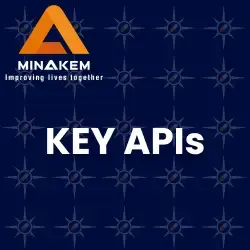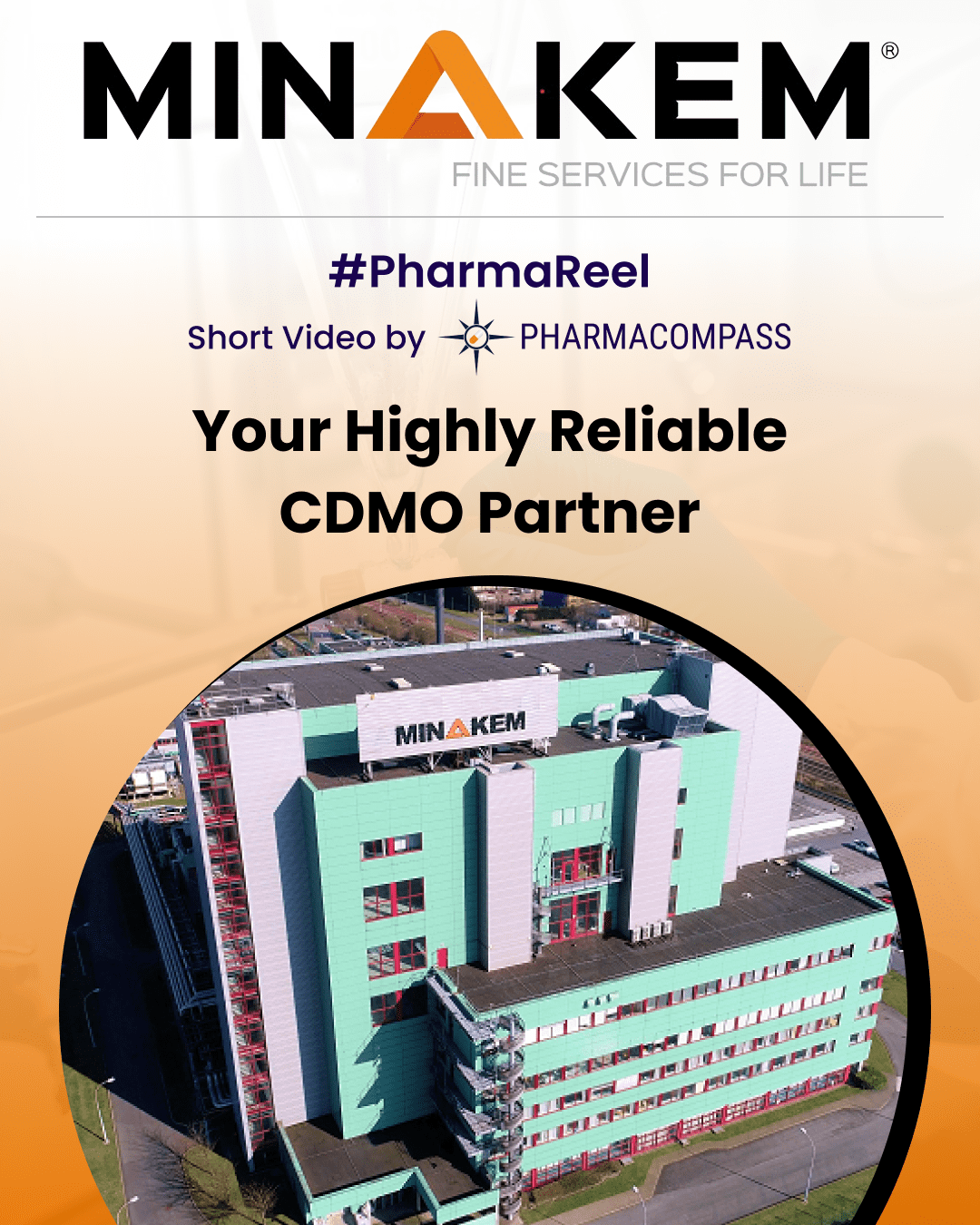14 Jan 2025
// PRESS RELEASE
05 Sep 2024
// PRESS RELEASE
25 Jun 2024
// PRESS RELEASE
Latest Content by PharmaCompass
 KEY PRODUCTS
KEY PRODUCTS KEY SERVICES
KEY SERVICES KEY EXCIPIENTS
KEY EXCIPIENTS
Minakem delivers API, HPAPI, steroids & CDMO services for generics with FDA/GMP certification, regulatory know-how & proven success.
About
CPhI North America CPhI North America
Industry Trade Show
Attending
20-22 May, 2025
euroPLX 88 LisboneuroPLX 88 Lisbon
Industry Trade Show
Attending
02-03 June, 2025
CPhI WW FrankfurtCPhI WW Frankfurt
Industry Trade Show
Booth #6.0D14
28-30 October, 2025
CONTACT DETAILS




Events
Webinars & Exhibitions
CPhI North America CPhI North America
Industry Trade Show
Attending
20-22 May, 2025
euroPLX 88 LisboneuroPLX 88 Lisbon
Industry Trade Show
Attending
02-03 June, 2025
CPhI WW FrankfurtCPhI WW Frankfurt
Industry Trade Show
Booth #6.0D14
28-30 October, 2025
https://www.pharmacompass.com/speak-pharma/minafin-appoints-s-bastien-poncet-managing-director-of-minakem-generics-new-therapies-pressrelease-with-pharmacompass
CORPORATE CONTENT #SupplierSpotlight
https://www.pharmacompass.com/radio-compass-blog/cdmo-activity-tracker-bora-polpharma-make-acquisitions-evonik-euroapi-porton-announce-technological-expansions
https://www.pharmacompass.com/radio-compass-blog/excipient-market-overview-roquette-seqens-evonik-make-strategic-moves-new-guidelines-deal-with-contamination
https://www.pharmacompass.com/radio-compass-blog/cdmo-activity-tracker-novo-s-parent-buys-catalent-for-us-16-5-bn-fujifilm-merck-kgaa-axplora-lonza-expand-capabilities

14 Jan 2025
// PRESS RELEASE
https://minakem.com/news/press-releases/fulvestrant-api-reducing-co2-footprint-by-3-4-mt-kg-with-an-innovative-gen2-process/

05 Sep 2024
// PRESS RELEASE
https://minakem.com/news/minafin-group-appoints-olivier-ubrich-as-ceo-of-health-chemistry-division/

25 Jun 2024
// PRESS RELEASE
https://minakem.com/news/the-ema-has-validated-the-updated-cep-of-vinorelbine-of-minakem-sole-manufacturer-in-europe/

17 May 2024
// PRESS RELEASE
https://minakem.com/news/minakem-canada-is-manufacturing-steroid-apis-in-a-brand-new-production-unit/

09 Apr 2024
// PRESS RELEASE
https://minakem.com/news/the-made-in-canada-label-for-api-manufacturing-is-garnering-increasing-interest-in-the-pharmaceutical-industry/

09 Mar 2024
// PRESS RELEASE
https://minakem.com/news/the-made-in-canada-label-for-api-manufacturing-is-garnering-increasing-interest-in-the-pharmaceutical-industry/
Services
API Manufacturing
API & Drug Product Development
Excipients
Excipients by Ingredients
Excipients By applications
Inspections and registrations
District Decision : Voluntary Action Indicated
Inspection End Date : 2022-03-11
City : Beuvry-La-Foret
State : -
Country/Area : FR
Zip : -
District : -
Center : -
Project Area : Monitoring of Marketed Animal Dr...
District Decision : Voluntary Action Indicated
Inspection End Date : 2022-03-11
District Decision : Voluntary Action Indicated
Inspection End Date : 2022-03-11
City : Beuvry-La-Foret
State : -
Country/Area : FR
Zip : -
District :
Center :
Project Area : Drug Quality Assurance
District Decision : Voluntary Action Indicated
Inspection End Date : 2022-03-11
District Decision : Voluntary Action Indicated
Inspection End Date : 2020-02-06
City : Corbais
State :
Country/Area : BE
Zip :
District : ORA
Center : CDER
Project Area : Drug Quality Assurance
District Decision : Voluntary Action Indicated
Inspection End Date : 2020-02-06
District Decision : Voluntary Action Indicated
Inspection End Date : 2018-06-22
City : Dunkirk
State :
Country/Area : FR
Zip :
District : ORA
Center : CDER
Project Area : Drug Quality Assurance
District Decision : Voluntary Action Indicated
Inspection End Date : 2018-06-22
District Decision : Voluntary Action Indicated
Inspection End Date : 2018-01-25
City : Beuvry-la-foret
State :
Country/Area : FR
Zip :
District : ORA
Center : CDER
Project Area : Drug Quality Assurance
District Decision : Voluntary Action Indicated
Inspection End Date : 2018-01-25
District Decision : Voluntary Action Indicated
Inspection End Date : 2016-04-22
City : Dunkirk
State :
Country/Area : FR
Zip :
District : ORA
Center : CDER
Project Area : Drug Quality Assurance
District Decision : Voluntary Action Indicated
Inspection End Date : 2016-04-22
District Decision : Voluntary Action Indicated
Inspection End Date : 2016-03-25
City : Beuvry-la-foret
State :
Country/Area : FR
Zip :
District : ORA
Center : CVM
Project Area : Monitoring of Marketed Animal Dr...
District Decision : Voluntary Action Indicated
Inspection End Date : 2016-03-25
District Decision : Voluntary Action Indicated
Inspection End Date : 2016-03-25
City : Beuvry-la-foret
State :
Country/Area : FR
Zip :
District : ORA
Center : CDER
Project Area : Drug Quality Assurance
District Decision : Voluntary Action Indicated
Inspection End Date : 2016-03-25
District Decision : No Action Indicated
Inspection End Date : 2015-09-24
City : Corbais
State :
Country/Area : BE
Zip :
District : ORA
Center : CDER
Project Area : Drug Quality Assurance
District Decision : No Action Indicated
Inspection End Date : 2015-09-24
District Decision : Voluntary Action Indicated
Inspection End Date : 2013-09-13
City : Beuvry-la-foret
State :
Country/Area : FR
Zip :
District : ORA
Center : CVM
Project Area : Monitoring of Marketed Animal Dr...
District Decision : Voluntary Action Indicated
Inspection End Date : 2013-09-13
 FULL SCREEN VIEW Click here to open all results in a new tab [this preview display 10 results]
FULL SCREEN VIEW Click here to open all results in a new tab [this preview display 10 results]ABOUT THIS PAGE
Minakem is a supplier offers 38 products (APIs, Excipients or Intermediates).
Find a price of Budesonide bulk with DMF, CEP, JDMF offered by Minakem
Find a price of Vinorelbine Tartrate bulk with DMF, CEP, JDMF offered by Minakem
Find a price of Esomeprazole Magnesium bulk with DMF, CEP offered by Minakem
Find a price of Vinblastine Sulfate bulk with DMF, CEP offered by Minakem
Find a price of Vincristine Sulfate bulk with DMF, CEP offered by Minakem
Find a price of Azaperone bulk with CEP offered by Minakem
Find a price of Fulvestrant bulk with CEP offered by Minakem
Find a price of Remifentanil bulk with CEP offered by Minakem
Find a price of Vinblastine Sulfate bulk with CEP offered by Minakem
Find a price of Vindesine Sulfate bulk with JDMF offered by Minakem
Find a price of Aliskiren bulk offered by Minakem
Find a price of Apixaban bulk offered by Minakem
Find a price of Budesonide bulk offered by Minakem
Find a price of Eslicarbazepine Acetate bulk offered by Minakem
Find a price of Esmolol Hydrochloride bulk offered by Minakem
Find a price of Esomeprazole Magnesium bulk offered by Minakem
Find a price of Esomeprazole Sodium bulk offered by Minakem
Find a price of Fluorescein bulk offered by Minakem
Find a price of Fluorescein Sodium bulk offered by Minakem
Find a price of Ibrutinib bulk offered by Minakem
Find a price of Lapatinib Ditosylate bulk offered by Minakem
Find a price of Methazolamide bulk offered by Minakem
Find a price of Metyrapone bulk offered by Minakem
Find a price of Mirabegron bulk offered by Minakem
Find a price of Pargeverine bulk offered by Minakem
Find a price of Pentamidine Isethionate bulk offered by Minakem
Find a price of Pyrazinamide bulk offered by Minakem
Find a price of Rilmenidine Phosphate bulk offered by Minakem
Find a price of Rilpivirine bulk offered by Minakem
Find a price of Rilpivirine Hydrochloride bulk offered by Minakem
Find a price of Rosuvastatin Calcium bulk offered by Minakem
Find a price of Solifenacin Succinate bulk offered by Minakem
Find a price of Sorafenib bulk offered by Minakem
Find a price of Succinylcholine Chloride bulk offered by Minakem
Find a price of Tofacitinib Citrate bulk offered by Minakem
Find a price of Vindesine Sulfate bulk offered by Minakem
Find a price of Full vestrant bulk offered by Minakem
Find a price of ASOXIME DIMETHANESULFONATE bulk offered by Minakem




